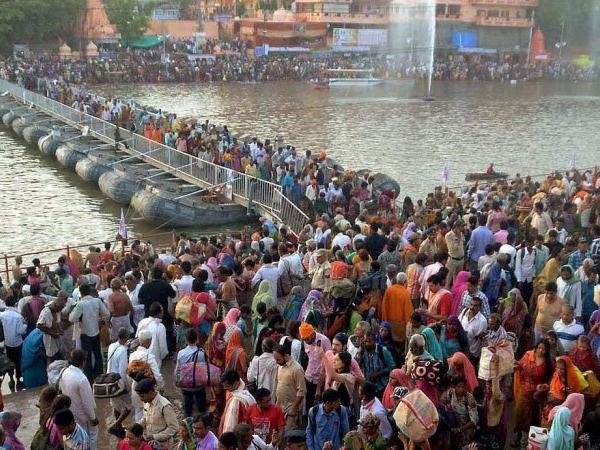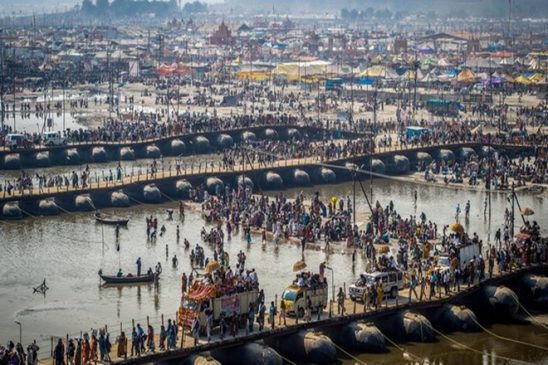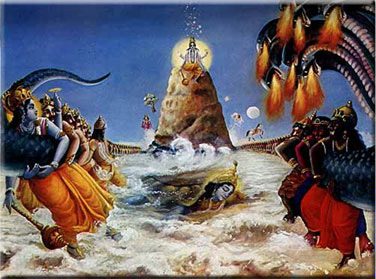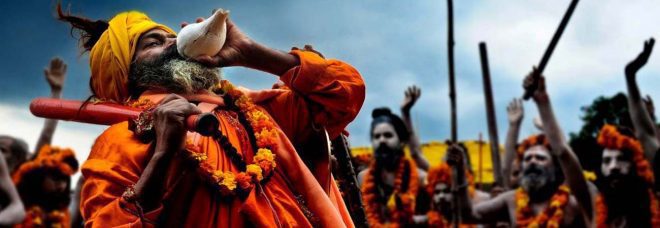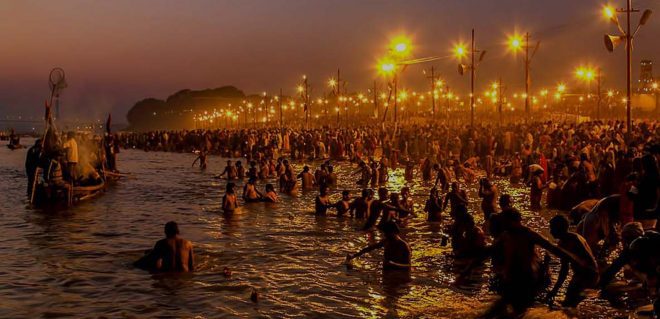Kumbh Mela is the largest cultural and religious human gathering on earth in which millions of devotees from all around the world gather together to bathe in the sacred river. It is believed that one who takes a dip in the water of the holy rivers attains moksha. It drives away all their sins and they are blessed by the divine and become eligible for the liberation from the cycle of birth and death.
(image source- google images)
Kumbh Mela is organized every three years on a rotation basis in Allahabad, Nashik, Haridwar, and Ujjain. This year, it is going to be organized in “the Sangam Nagri- Prayagraj” (earlier known as Allahabad) starting from 15th January to 4th March. Unlike Maha Kumbh (Once in 12 years) it is Ardh Kumbh (once in 6 years) also called Half Kumbh which is only held in two places in India i.e. Allahabad(Prayagraj) and Haridwar.
Why Kumbh Mela is Celebrated?
In the Hindu story associated with the Kumbh Mela, even the gods seek to overcome death. The ancient origin of Kumbha Mela, as per the Vedic literature is at least 850 years old. It is believed that Adi Shankaracharya had started it, but as per other sources, there was a time when Gods and Goddess’ used to reside on earth. Due to a curse by Sage Durvasa, they started to lose their powers. A havoc was created by the demons or the Asuras in the world at that time. Lord Brahma advised the Gods to have the ‘Kumbha of Amrita’ or the ‘Pot of Immortality’ in order to regain their strength. Gods invited the Asuras to help them to take the Amrita out of the ocean. The Gods and demons desired to churn the ocean to produce the nectar of immortality and agreed to share it afterward.
The Mandara Mountain was used as a churning rod, and Vasuki, the king of serpents, became the rope for churning. With the Gods at Vasuki’s tail and the demons at his head, they churned the ocean for a 1,000 years. A pot of nectar was eventually produced, and both the Gods and demons became anxious. The Gods, being fearful of what would happen if the demons drank their share of the nectar of immortality, stole away the pot and hid it. However, the Asuras soon realized the Gods’ plan of not sharing the Amrit with them. This led to the Asuras chasing the Gods for 12 human years. During this waging war between the Demons and Gods over the Amrit, drops of Amrit fell on four places.
(image source- google images)
According to tradition, these drops landed on the four locations where the Kumbh Mela is observed today:
1. Haridwar, where the Ganga enters the plains,
2. Prayag, at the Triveni Sangam,
3. Nashik, on the Godavari River in Maharashtra, and
4. Ujjain, on the Shipra River in Madhya Pradesh.
Each site’s celebration dates are calculated in advance according to a special combination of zodiacal positions of Brahaspati (Jupiter), Surya(the Sun) and Chandra(the Moon).
Skanda Purana contains the story and links it to the astrological conjunctions when the four Kumbh Melas take place and the places where the drops of nectar were spilled. It is generally agreed that the mention of a large astrologically determined mela occurred first in relation to the Kumbh Mela at Haridwar. According to Prof. D.P. Dubey, “It appears that the Kumbha Parva derives its name from an auspicious occasion of ritual bathing that used to take place at Haridvara, every twelfth year, when Jupiter was in Aquarius, and the sun entered Aries.” The legend of the immortal nectar aside, the praises of bathing in the San-gam and sipping its waters are ubiquitous in the Puranas.
“From untruth, lead us to truth; from darkness, lead us to light; from death, lead us to immortality.” This oft-quoted prayer from the Upanishads reveals a more universal truth that spans cultures and religions—the yearning for immortality.
What is the spiritual pull of the Kumbh Mela?
(image source- google images)
For most pilgrims, a holy dip in the rivers holds the most spiritual value. They dip fully into the waters once, twice, three times, and then take the waters in their cupped hands to pour it again into the river as an offering to the gods and to the ancestors. They make offerings of flowers and oil lamps, floating them into the current of the mother waters. In the evening, the pilgrims might come to the river bank for one of the Aratis (lamp offerings) that are performed by pujaris (priests) who raise huge, multi-wicked oil lamps to the river. The rites are simple but absolutely central to the spiritual experience of the Kumbh Mela. This is what they have come for. For that kalpavasis who have vowed to stay for a whole month, Ganga snan is a once or twice-a-day rite. Shahi Snan, the Royal Bathing Days are astrologically auspicious, so on these days, the power of the holy waters is amplified. On these days, the ordinary bathing of pilgrims takes place in a crowd as many as twenty million. There are three traditional Shahi Snan days: Makar Sankranti, Mauni Amavasya, and Vasant Panchami. There are other spiritually auspicious bathing days Paush Purnima, Maghi Purnima and Maha Shivratri but above three are the great days of the Royal Procession. that will
Two examples of many hundreds may suffice:
“If one bathes and sips water where the Ganga, Yamuna, and Sarasvati meet, he enjoys liberation, and of this there is no doubt”. – – Padma Purana UttaraKhanda 23.14
“Those who bath in the bright waters of the Ganga where they meet the dark waters of the Yamuna during the month of Magh will not be reborn, even in thousands of years”. – Matsya Purana 107.7
(image source- google images)
Thousands of pilgrims and tourists descended on Prayagraj for the first ‘Shahi Snan’ on Tuesday, 15th January to mark the start of Kumbh Mela that will continue till March 4. An estimated 130-140 million people are expected to visit the Mela over the course of the next 45 days. This Ardh Kumbh there is a lot more preparations have been done by UP Gov to make it more Memorable. The whole city is painted in the memory of Kumbh and decorated beautifully. This Kumbh is worth a visit, what do you think guys? Are you going?

